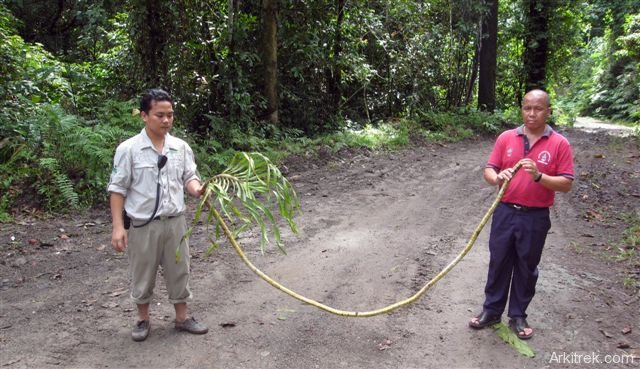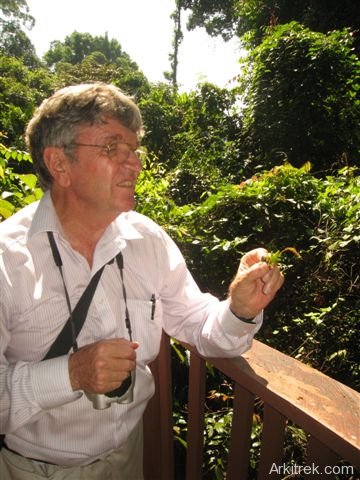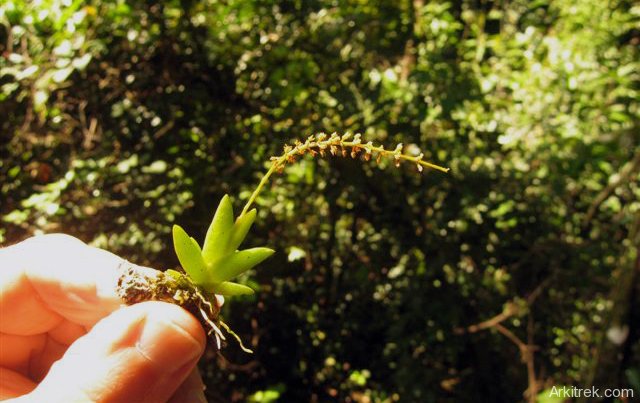Little & Large of the Orchid World
Text by Ian Hall
Photos by Ian Hall, Serena Lamb and Eyen Khoo
Horticulturalist and orchid expert Tony Lamb has thrown down the gauntlet to describe the world’s largest orchid. The Tiger Orchid, Grammatophyllum speciosum is the undisputed king of the orchid world but where is the largest specimen to be found in the wild? The question was raised during a walk along the access road to Borneo Rainforest Lodge (BRL) in the Danum Valley Conservation Area in Sabah.
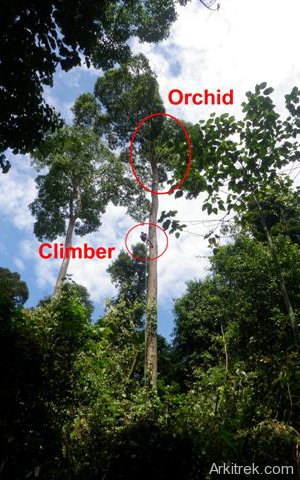 The orchid that caused Tony to stop in his tracks was so big that despite walking past it every day I had not even realised that it was an orchid. There is only so much you can teach yourself about the countless species in the web of life of a tropical rainforest. It as a treat to be in the company of Tony Lamb and Anthea Phillipps who knew far more than me.
The orchid that caused Tony to stop in his tracks was so big that despite walking past it every day I had not even realised that it was an orchid. There is only so much you can teach yourself about the countless species in the web of life of a tropical rainforest. It as a treat to be in the company of Tony Lamb and Anthea Phillipps who knew far more than me.
We were at BRL to assess the nature interpretive information that is presented to guests not lucky enough to have such knowledgeable guides. Through audio visual and textual media we can give an insight into the wonders of plant / animal interactions and other ecosystem functions, plus of course trivia such as; how big is the world’s largest orchid?
To answer this question Tony recruited some tree climbing botanists from the Sabah Forestry Department to physically measure the BRL Tiger Orchid. At 30m above the ground this was no easy task but climber Jeisin Jumian counted 90 live pseudobulbs up to 3.3m in length with leaves extending a further 0.3m.
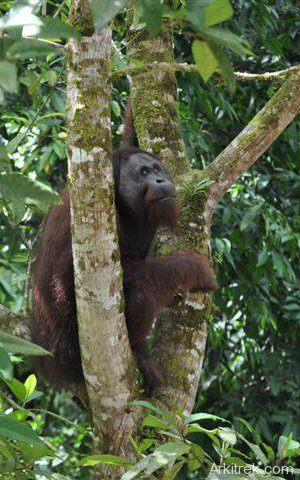 Back at the Lodge we watched one of the plant/animal interactions for which BRL is famous. An old male orang-utan munching tarap fruit next to the veranda. All the guests were ecstatic to see a wild orang utan so close and after lively debate Tony and Anthea agreed on the species of tarap being eated as Artocarpus rigidans.
Back at the Lodge we watched one of the plant/animal interactions for which BRL is famous. An old male orang-utan munching tarap fruit next to the veranda. All the guests were ecstatic to see a wild orang utan so close and after lively debate Tony and Anthea agreed on the species of tarap being eated as Artocarpus rigidans.
No trip to BRL would be complete without traversing the canopy walkway suspended 20m above ground between emergent dipterocarp and mengaris trees. The walkway is at barely half the height of these enormous trees but sensationally within the rainforest canopy.
Canopy science is at the frontline of ecological research both because it is hard to get to and because this is where most of the primary productivity of the rainforest occurs. Last year a new species of bird was described from the BRL canopy walkway. That one of the most intensely observed bits of canopy in Sabah can still yield new vertebrate species hints at how much there is still to learn.
Hot on the heels of canopy science is canopy tourism. Being in the canopy is a dramatic experience that allows your imagination to take flight. It is a vertical super natural world where the trees provide a structure to be inhabited by plant families like ginger, pandanus, lichopodium, aeroids, ferns, orchids, mosses and the animals that they are interdependent with.
To recognise and know the names of some of these living things allows us to talk about them and share our observations. This becomes knowledge which if it can be imparted to tourists will greatly enhance their experience. After all, one of the main points of travel is so that you can go back home and brag about what you have seen and done.
On the last platform of the canopy walkway, Tony paused to pick up what I thought was just a leaf. It turned out to be an entire plant fallen from the canopy, an orchid of unknown species hardly bigger than a thumb nail and with a flower stalk barely 40mm long, bearing flowers 1mm in diameter. A contender for world’s smallest orchid he reckoned.
By this stage my mind could cope with no more latin names so we retired to the bar where I was very pleased to hear Tony ordering a double gin. ‘For scientific purposes’ he winked and poured it into a specimen jar containing the tiny orchid.
Related posts
%RELATEDPOSTS%



